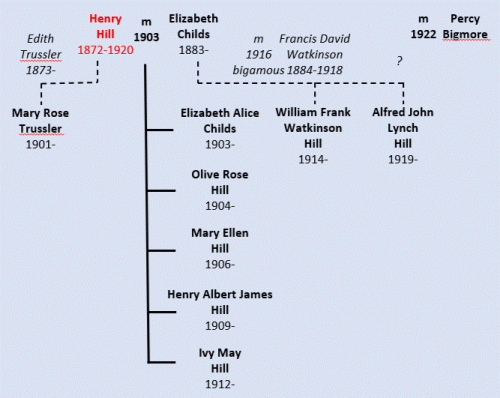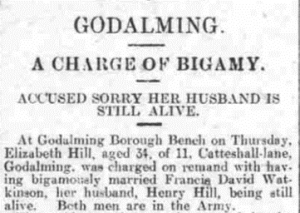HENRY HILL
Subject Name: Henry Hill (b 1872 – d1920)
Researchers : Mike Brock and Carol ThompsonReearchere Brock
Henry Hill’s life story reads like an over-imaginative soap opera – but one that is actually true!
 Henry was born on 21 November 1872 in the Guildford Union Workhouse, the son of unmarried 32-year old Elizabeth Hill of Godalming. No father was named on the Workhouse Register of Births, and it is not known if Henry ever knew who his father was. Henry was baptised there on 9 February 1873.
Henry was born on 21 November 1872 in the Guildford Union Workhouse, the son of unmarried 32-year old Elizabeth Hill of Godalming. No father was named on the Workhouse Register of Births, and it is not known if Henry ever knew who his father was. Henry was baptised there on 9 February 1873.
At the time of the 1871 Census, Elizabeth had been living with her widowed father James, age 59, and her 17-year old brother John in Catteshall Lane, Godalming. James passed away in 1874, and around that time John was admitted to the Guildford Union. John was to spend the rest of his life there, which was almost 40 years, so it seems likely that he was unable to care for himself in some way. Where Elizabeth was in the eight years after Henry’s baptism is unknown, but it appears she was not at the family home when her father passed away because a neighbour was witness to his death, not Elizabeth.
In 1881 Elizabeth and Henry were in the Guildford Union Workhouse, with Elizabeth was noted as a domestic servant. It’s possible that she and/or Henry had been living elsewhere at some stage, but equally they could have been in the Workhouse since Henry’s birth. Henry was now age eight, and most likely would have been attending the school in the Workhouse.
Ten years later, life for Henry and his mother was looking much better. The 1891 Census showed that Henry was now in employment, working as a labourer for one of the local paper mills and boarding with Charles and Mary Trussler in Mead Row, Godalming. Elizabeth was a live-in house servant in nearby Busbridge.
In 1901, Henry remained a labourer at a paper mill and living in Meadrow, and still had a room with Charles and Mary Trussler next to the Unitarian Chapel and Half Moon beer house. On the day of the Census, 31 March, their niece Edith Trussler, a 28-year-old unmarried laundress, was paying them a visit. Less than eight months later, on 12 November, Edith gave birth in the Guildford Union Workhouse to Mary Rose Trussler – the daughter of Henry Hill.
Henry clearly ignored his duties as a father, because on 14 February 1902 Edith summoned Henry for maintenance for their daughter. The bench “considered the case proved”, ordering Henry to pay 3 shillings and 6 pence a week (17.5p in today’s money) plus 22 shillings costs.
This did not stop Henry 18 months later on 31 October 1903 marrying 20-year old spinster Elizabeth Childs at Hambledon Register Office. Elizabeth had very recently given birth to a daughter who was almost certainly Henry’s child.
Henry’s mother had continued to work for the same couple as a live-in servant into the early stages of the 20th century, but by 1904 she was back in the Guildford Union suffering from a number of ailments. She passed away there on 29 November 1904 age 64.
Henry’s problems with the affiliation order for the maintenance of Mary Rose had not gone away during this time as he continued to avoid paying Edith Trussler for her upkeep. So in December 1905 he was sent to prison for seven days, and again for 14 days in January 1906 when he still didn’t pay.
Things came to a head in the summer of 1906 when Henry was in court once more, having not paid any money to Edith for over a year. The Surrey Times of 28 July quoted Henry, who now had two children by his wife Elizabeth, complaining that “he earned 15 shillings a week as a carman, and that it was impossible to pay 2s 6d a week out of that”. The article went on to say that Henry expressed his willingness to look after Mary Rose in his own home, but Edith would not agree to this: “I would sooner go to the Workhouse than give it up”, she said. Henry’s wife Elizabeth added that if he was sent to prison it would mean that she and her two children would suffer.
The case was adjourned for a month to give Henry the chance to start paying. As he still did not, the court reconvened in August 1906 when it was decided, after a private discussion between the magistrate, Henry, Edith and Elizabeth, that he would pay 1 shilling (5 new pence) per week towards Mary’s upkeep. The case was again adjourned for one month to see what contribution Henry did make, otherwise “the law would have to take its course”. In September Edith reported that Henry had still not paid anything. Henry paid 4 shillings there and then, and said he would “endeavour to pay” – the case was adjourned for three months.
A couple of weeks later, Henry’s wife Elizabeth was back before the Godalming Bench, this time following a “squabble” with neighbour Amelia Ellis during which Elizabeth claimed she was hit by Amelia’s husband William. Henry was also involved, as he said that his shirt and waistcoat were torn as he scuffled with William, while Amelia alleged that Elizabeth had attacked her husband with a hat-pin. The judge ruled in favour of Elizabeth, fining William five pounds plus costs.
Elizabeth was about six months pregnant at this time with their third child, Mary Ellen, who was born in December 1906. Their only son, Henry Albert James, was their fourth child born three years later.
The 1911 Census provided a startling revelation about Edith Trussler, the mother of Henry’s first child Mary Rose. Age 38, she was still living with her uncle and aunt in Meadrow, Godalming, but it stated, in the frank language of the time, that Edith was an “imbecile”. Edith had clearly been well enough to be able to stand her ground in front of a magistrate in 1906, so one can only presume her health had dramatically declined after that. Her daughter Mary Rose was missing from the Census but remarkably, the next record found for her is her marriage in 1918 – in Australia! All that is known about Edith after 1911 is that in 1939 she was in the Hambledon “Public Assistance Institution” (the re-named workhouse). Her ultimate fate is unclear.
Henry and Elizabeth and their four children in 1911 were living at 43 Catteshall Lane, Godalming. Henry, 34, was noted as a carter at a timber yard. Their fifth child Ivy May arrived in 1912, but the family unit was by now on the point of collapse. At 7 Catteshall Lane was Francis Watkinson, a 25-year old unmarried carter at a timber merchant, so almost certainly a colleague if not a friend of Henry. Soon after this Francis became a lodger with Henry’s family. In Henry’s opinion, Francis became too close to Elizabeth, so Henry decided to leave them to it and moved out. Where Henry went to is unclear, but it may well have been Redhill where tragedy would strike some years later.
Henry was undoubtedly correct about the relationship between his wife and Francis, as in the latter stages of 1914, shortly after The Great War had started, Elizabeth gave birth to William Frank Watkinson Hill.
Around this time, many thousands of men enlisted in what they believed was going to be a quick and glorious campaign against Germany. It would seem likely that Henry, presumably living alone, would have been one of those, even though he was now over 40. It also seems that his wife was aware of him signing up too, and the news of a soldier called Hill being killed in action in 1916 was to lead to a chain of events culminating in a very public trial.
Records for World War 1, as it came to be known, are not complete, as many of them were destroyed in a bombing raid during World War 2. Henry’s record was one of those lost, but one that did survive was that of Elizabeth’s lover, Francis Watkinson, who signed up at Chertsey on 15 February 1916. He named his widowed mother Caroline as his nearest relative, with her address as 11 Catteshall Lane, Godalming, the same as Elizabeth Hill.
Shortly after Francis signed up, and before his first posting, Elizabeth and Francis decided to get married, so on 1 July 1916 they tied the knot in Farnham Registry Office.
This proved to be a disastrous move, as in May 1917, Elizabeth confessed to the police that she had entered into a bigamous marriage with Francis, as Henry was still very much alive serving with the Army in France. Stories like these were food and drink to the newspapers, with the Surrey Advertiser devoting many column inches to the tale of deception and half-truths.
Elizabeth told the judge that she had been informed at the time of her marriage to Henry in 1903 that it “was only good for seven years” because it was conducted in a Registry Office. She also said that she believed that she needed to be married to Francis to be able to receive the Soldiers’ Separation Allowance, although that was not true as the claim she sent to the War Office three months before her marriage had been approved, coincidentally receiving the acceptance of the claim on the day of her “marriage”. “A wedding present from the War Office?” the judge exclaimed, causing laughter in the court.
 Elizabeth also said that she had taken to the police a few years earlier a letter written by Henry around the time of their split in which he had expressed an intention to commit suicide. She added that in their time together, Henry had knocked her about and led her a terrible life. When she had read in the newspaper in 1916 of the death of a soldier called Hill, she assumed it was Henry, but after discovering it wasn’t, she said to the judge “I am only too sorry that he is still alive”.
Elizabeth also said that she had taken to the police a few years earlier a letter written by Henry around the time of their split in which he had expressed an intention to commit suicide. She added that in their time together, Henry had knocked her about and led her a terrible life. When she had read in the newspaper in 1916 of the death of a soldier called Hill, she assumed it was Henry, but after discovering it wasn’t, she said to the judge “I am only too sorry that he is still alive”.
The judge was clearly sympathetic towards Elizabeth, giving her a nominal sentence of just two days in prison before being released.
With no record existing of Henry’s military service, it is not possible to know much about what he was doing during that time, although Ada Elliott, his former neighbour in George Street, Farncombe, said during the trial that she had seen him in December 1915.
Henry did survive the War, but Francis did not, as he lost his life in Flanders on 27 May 1918. Henry almost certainly did not return to his wife Elizabeth, as just under a year after the Armistice, she gave birth on 6 November 1919 to Alfred John Lynch Hill at 11 Catteshall Lane. No father was named on the birth certificate although there is probably a big clue to who he was in the child’s name!
Henry’s most likely destination was Redhill, where he died age 48 in a dreadful accident on 21 December 1920. Henry had been working in the sidings of Redhill Goods Station and while trying to unload some hay, he was crushed between the buffers, dying instantly.
The inquest held three days later on Christmas Eve called upon Henry’s estranged wife to identify the body. Interestingly, the death certificate noted Henry’s address as Elizabeth’s at 11 Catteshall Lane, although at the time of the accident the newspaper reported that Henry was living at 109 Cromwell Road, Redhill, very close to the railway station. It was concluded that his death was an unfortunate accident, and no one was to blame.
Henry’s death now left Elizabeth able to legally remarry, and on 21 January 1922, the 39-year old married bachelor Percy Bigmore at Godalming Parish Church.
Henry’s life was never easy, with many problems that he had brought upon himself. However, he was unable to defend himself at his wife’s bigamy trial, where she made allegations about his character. It would’ve been interesting to hear what he would have had to say about her behaviour during their marriage, and about the letters he had written in which Elizabeth said he had mentioned suicide. There does seem the possibility that he did see her or at least his children in the last months of his life, as her address was put on his death certificate. Wherever the full truth lies in Henry’s story, it was a sad end to the colourful life of a man who had spent his early years in the Guildford workhouse, had navigated his way through illegitimacy and serious marital issues, and had survived World War 1 only to lose his life in an avoidable work accident.
November 2020
Sources : Ancestry.co.uk
FindMyPast.co.uk / Britishnewspaperarchive.co.uk
Surrey History Centre – surreycc.gov.uk/culture-and-leisure/history-centre
Government Register Office – gro.gov.uk
New South Wales Australia Births Marriages Deaths – nsw.gov.au
Full references available here.
